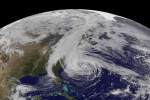
View of Hurricane Sandy. NASA Earth Observatory image by Robert Simmon with data courtesy of the NASA/NOAA GOES Project Science team.
Digging deeper, however, one found that there were other long-term issues that reach beyond the Jersey shore. In particular, insurance companies were forced once again to come up with better models for assessing the impact of a storm surge such as Sandy’s. Digging one layer deeper, one finds work done by many statisticians and mathematicians to better model and simulate a storm surge and to better predict the expected cost of damage from such a surge.
One learns that insurance companies –- quiet employers of people in mathematical sciences — are working hard to develop and improve impact-forecasting models for storm surges. For example, Aon Benfield is further developing impact-forecasting models, noting that “it is now more important than ever to respond to these large events by researching, developing and implementing flood catastrophe models that can better analyze the hazard of hurricane coastal and inland riverine flooding.” Work like this is crucial to efforts of insurers and re-insurers to better perform risk assessment.
Improving models and simulations for storm surge and improving statistical tools for risk assessment are major research topics within the mathematical sciences community. To cite one example, SIAM News covered work by Clint Dawson and his co-workers on modeling hurricane storm surge — Uncertainty Quantification 2012: Modeling Hurricane Storm Surge. This article gives on overview of the mathematical/computational issues in creating high-fidelity simulations of a storm surge.
Of course, the National Oceanic Atmospheric Administration (NOAA), the agency that plays a major role in weather prediction, also is involved in developing storm surge models in collaboration with research mathematicians and computational scientists. NOAA’s web site provides information on the models being developed.
NOAA’s models also caught the attention of the media; as an example, The Washington Post covered NOAA models in the August 2013 story Hurricane Center Gives Storm Surge Model a Boost.
It is interesting to those involved in the mathematical and computational aspects of these issues to see media coverage that shows the impact of the ongoing research. At the same time, it is somewhat disappointing that this work is often not mentioned in the media reports.